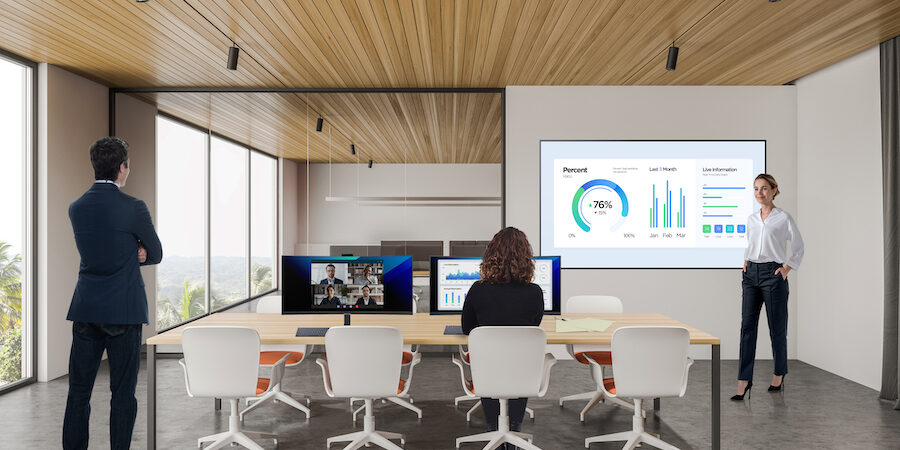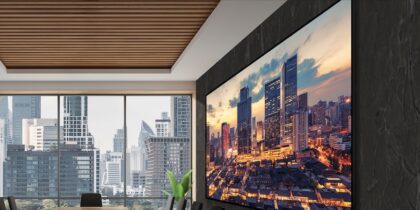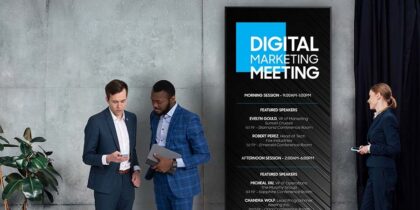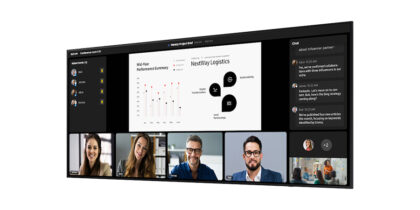Today, according to a 2023 Gallup poll, the majority of remote-capable employees are working hybrid or exclusively remote, and less than 10% say they prefer to work on-site. Yet, the need for face-to-face business meetings and in-person collaboration is real, and it’s in almost every business’s best interest to get employees back to the office. As a result, some companies are overhauling their spaces and installing new technology to enhance and encourage this necessary teamwork while at the same time supporting a healthy and invigorating office culture.
But what does that look like and what office collaboration tools should your business incorporate to make it succeed? Read on to find out.
How to create the ultimate collaboration experience at the office
Here are seven tips for creating an optimized, inviting workspace that encourages employee collaboration.
1. Create huddle spaces for informal brainstorming
Huddle rooms are small meeting spaces that help teams get together and work on projects. Different from old-fashioned conference rooms, these are more informal areas equipped with comfortable seating arrangements — even couches and armchairs — and small tables for laptops. The huddles inside them are also more informal and conversational, enhancing the free flow of communication. To support this further, these spaces may also include huddle room technology, such as interactive whiteboards and video conferencing equipment.
How to plan and deploy direct view LED signage
Everything you need to know about choosing your LED displays for optimal viewing indoors and out. Download Now
2. Install stronger infrastructure for hybrid communication
Whether you’re holding a meeting in a huddle room or in a more formal area, chances are that some of the people attending will still be remote. This means that every meeting place must have high-quality equipment to facilitate that connection. This should include easy-to-use monitors at the very least, but you may want to consider a larger display that better highlights communication, such as The Wall All-in-One, as well. Other must-haves include good lighting, strong wireless or wired internet connections and mounted or built-in speakers.
3. Set aside quiet spaces where people can relax
Employees who are used to working in an empty house or their quiet home office have grown to love the ability to relax when necessary and are reticent to give it up for the hustle and bustle of an office environment. That’s why it’s important to provide quiet areas at the office that can provide this relaxation. Huddle rooms are one option, but you can also consider installing privacy pods — now common at cooperative workspaces — as well as setting aside specific offices with doors that employees can use as needed. Don’t forget to create signage that lets people know they are entering a quiet room and to refrain from eating, talking and using laptops without earbuds. You might also soundproof a meeting area and ask employees to take their noisy activities there.
4. Give the office a casual vibe
While you may still need conference or meeting rooms that are more formal — especially for client or vendor meetings — employees will appreciate a homey reboot for at least part of the office. Quiet rooms, as well as cubicles, offices and common areas, should have comfortable lighting, inviting furniture, plants and flowers, and artwork. Casual elements like these make it easier for people to relax and collaborate, and perhaps even forget they are at the office.
5. Cater to basic needs of employees
Working from home, employees got used to moseying into the kitchen and making coffee or tea or grabbing a quick bite to eat. While it might seem expensive, providing hot and cold beverages, as well as snacks and lunch, can pay off quickly, according to research. Hungry employees can’t think as well, so fuel your workforce for better collaboration and ideation. Indeed, the very act of providing a lunch brings your employees together, rather than sending them off separately in all directions. They may also really appreciate the dollars it saves them.
6. Make it easy for people to drop in and out of the office
Ideas flow when there are no roadblocks to overcome. To this end, it should be easy for employees and office visitors to hook up their laptops or screencast their mobile devices. This enables them to get right to work without stress or headaches. In addition to videoconferencing and other technology necessary in the hybrid office, it will be crucial to purchase high-quality, easy-to-use monitors, such as the ViewFinity S65VC Ultra-WQHD, while providing employees the space and resolution to share their vision.
7. Pursue employee well-being
Employees need to know you care. In fact, more than 9 out of 10 employees surveyed by the American Psychological Association said it’s either very or somewhat important to them to work for an organization that values their emotional and psychological well-being. Allowing employees to take meaningful breaks and incorporating them with intention into the workday becomes all the more important as a way to recharge, notes Harvard Business Review. If they can take a break outdoors or in green spaces, the impact can be even greater, returning them to work with fresh collaborative juices flowing.
Design for collaboration
Collaboration does not always happen naturally on its own — especially in a rigid, formal office environment that most employees don’t really want to be working in. The feeling has become even stronger after years of remote and hybrid work, making it all the more important for employers and managers to rethink and redesign the workspace with collaboration tools for business to support the collaboration and teamwork they seek.
See the full range of Samsung video conferencing solutions to find the best fit for your needs. Also, learn why you should add solid state drives to your office makeover plans.








